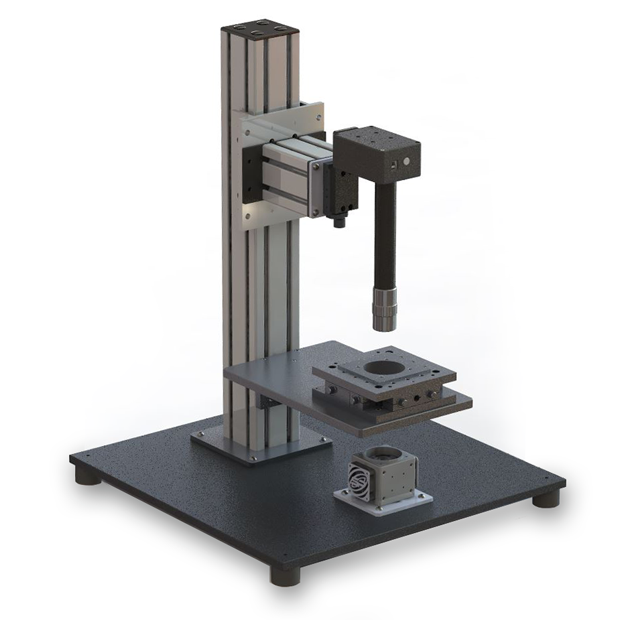+1 (608) 224-1230
GFP Products

With traditional photoelasticity, an engineer had to deal with the tedium of both coating applications and fringe counting. With the Grey Field Polariscope, Photoelastic Stress Analysis (PSA) is now fully automatic. After you paint, just aim the polariscope at your component or specimen and “shoot.” The image of the high strain or stress area is displayed digitally on the system’s computer. The GFP system interpolates the data and outputs an image showing the maximum inplane shear and the direction of the first principal strain.
Key Points about Photoelasticity
- Full-field
- Thin plastic coating
- In-plane shear strains
- Directions of principal strains
- Simple static loads including assembly stresses
- Should view normal to surface
- Can measure residual stress in glass and plastic
Key Features of GFP Systems
- Automated full-field strain measurement
- Compatible with all coatings
- Thickness measurement via tinted coatings
- 20 microstrain resolution typical
- Sub-fringe or multi-fringe
- Simple static loading
- Traceable system calibration
- No fringes to analyze
- Automatic measurement of coating thickness
- Fully computerized digital system
- Thin easier to apply coatings
GFP technical specifications vary depending on the system. We’re happy to discuss detailed technical specifications and help match a system to your specific application. Simply contact Stress Photonics via our online contact form or call us at (608) 224-1230.
GFP
Photoelastic Stress Analysis (PSA)
Photoelasticity makes use of the optical phenomenon of stress causing a change in the birefringence (ability to polarize light) of transparent or translucent materials. For opaque materials a clear paint-on coating is used as a strain witness; a full-field strain-gague.
The Grey Field Polariscope (GFP) is a modern Photoelastic Stress Analysis System (PSA) system that quickly produces full-field images of structural stresses and strains. In transparent materials, most importantly automotive glass, the GFP measures the critically important stresses intentionally manufactured into a structure. Residual stress analysis in glass is an important specialty of the GFP line of instruments.
Image Stresses in Just Seconds!
Stress Photonics has developed the GFP line of polariscopes to image and report stresses full-field stress patterns. Two instrument heads form the basis for the product line. The GFP 1600 is based on a video camera with optical elements that are rotated into the optical train. The GFP 2600 has a single innovative lens attached to a video camera to make it a real-time photoelastic polariscope. Every frame is a complete stress image. Both systems have their place in the wide range of applicability of PSA.
Powerful Instruments and Simple User Interface
When the instrument is powerful it means that the use is easy. The GFP systems do all the tedious work of converting a complex system of images into a quantitative image of stress or strain. Like the images from Finite Element Analysis, the GFP photoelastic images provide an intuitive understanding of the flow of stress through a structure.
The DeltaVision user interface offers the familiar environment of Windows based engineering programs. The user has easy control of data acquisition, reporting, and archiving. Data can be reported out as images or exported as data sets for comparison or communication.
The data viewer version of DeltaVision can be installed on any Windows computer, no license required.
Powerful and Simple Modes of Operation
The GFP has many features that make operation simple.
- Video camera-like aiming and focusing
- Virtual instrument panel for control and image acquisition
- Serially repeated measurements
- In the case of the GFP 2600, video recordings of dynamic stresses
Talk to an Expert!
Click the button below to contact Stress Photonics. Our team of experts are on hand to discuss even the most unique application and help you find the right technology and instruments.
Contact Us
Stress Photonics products and expertise in Photoelastic and Thermoelastic methods are applicable to full-field stress and strain measurement, and glass inspection.
About
- History
- Leadership
- Markets
- Awards
Products
- DeltaTherm
- Grey Field Polariscope
- Glass Inspection
Applications
- Component Testing
- Glass Inspection
- Residual Stress in Transparent Materials
- Micro-mechanics
- FEA Validation
Getting Started
- Tutorials
- Resources